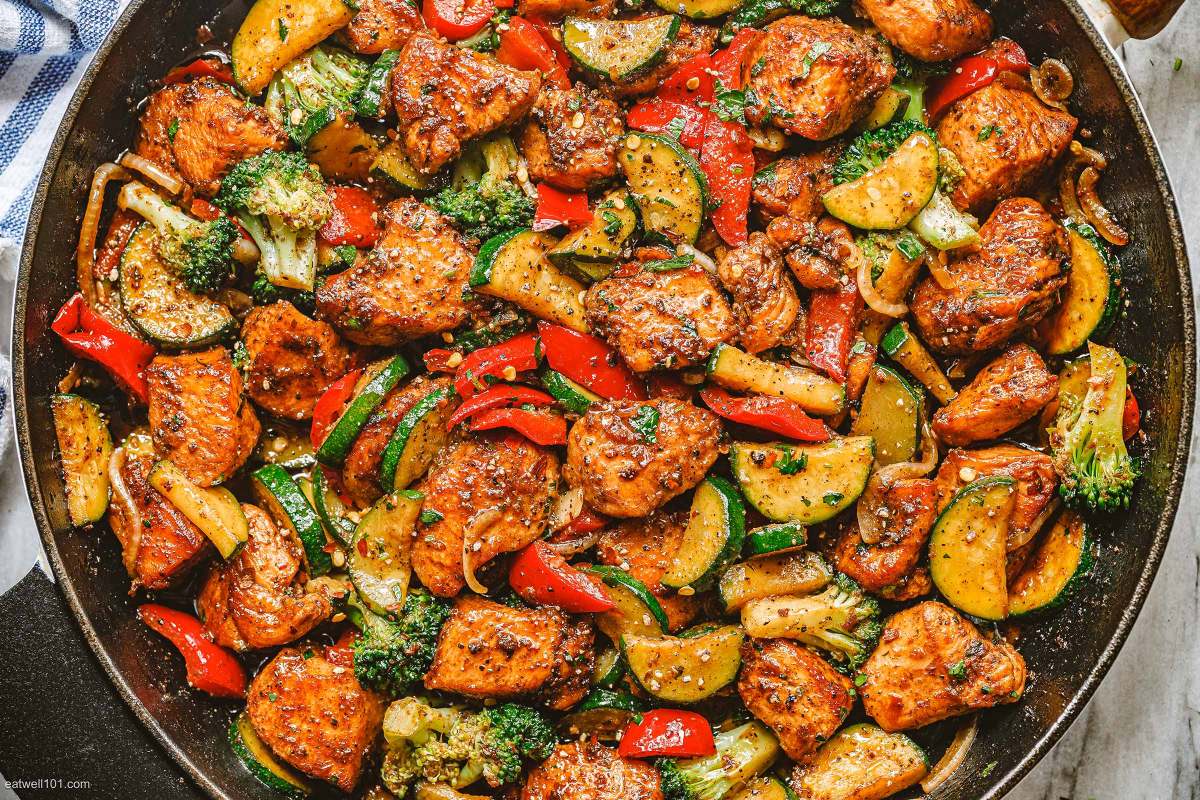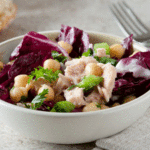Unleash the vibrant potential of vegetables! This culinary journey explores a world where vegetables aren’t mere side dishes, but the radiant stars of the plate. Prepare to be captivated by five show-stopping recipes, each showcasing unique flavor profiles and stunning visual appeal. We’ll delve into diverse cooking methods, unlocking the secrets to maximizing vegetable flavor and texture. Discover unexpected flavor combinations that elevate simple ingredients to gourmet heights, and explore dietary adaptations to suit every palate. Get ready to transform your perception of vegetable cooking—one delicious bite at a time.
From the sizzle of perfectly roasted vegetables to the satisfying crunch of a vibrant stir-fry, we’ll equip you with the knowledge and inspiration to create vegetable masterpieces. We’ll uncover the magic of pairing unexpected flavors, like the warmth of harissa-spiced carrots with the delightful crunch of pistachios. We’ll also guide you through elegant plating techniques, transforming your creations into edible works of art. This isn’t just about cooking; it’s about celebrating the beauty and deliciousness of vegetables.
Flavor Combinations that Elevate Vegetable Dishes
Unleashing the full potential of vegetables often lies in exploring unexpected flavor pairings. Moving beyond simple butter and salt, we can create vibrant and complex dishes by thoughtfully combining contrasting and complementary tastes and textures. The following examples demonstrate how seemingly disparate ingredients can harmonize beautifully, transforming humble vegetables into culinary masterpieces.
Unexpected Flavor Combinations for Vegetables
The magic of flavor lies in the interplay of sweet, sour, salty, bitter, and umami. Mastering these elements allows for the creation of dishes that are both exciting and satisfying. The following five pairings showcase this principle, using diverse textures and flavors to elevate the humble vegetable.
- Roasted Carrots with Harissa and Pistachios: The sweetness of roasted carrots is beautifully counterpointed by the fiery warmth of harissa paste, a North African chili paste. The crunchy pistachios add a textural element and a subtle nutty flavor that complements both the carrot and the harissa. The combination creates a dish that is simultaneously sweet, spicy, and savory.
- Asparagus with Lemon, Parmesan, and Toasted Breadcrumbs: The delicate bitterness of asparagus is balanced by the bright acidity of lemon juice. The salty, sharp bite of Parmesan cheese adds a creamy richness, while the toasted breadcrumbs provide a satisfying crunch. This combination showcases the versatility of asparagus, moving it beyond a simple side dish.
- Roasted Brussels Sprouts with Balsamic Glaze and Pomegranate Seeds: The slightly bitter Brussels sprouts are transformed by the sweet and tangy balsamic glaze. The juicy pomegranate seeds add a burst of tartness and a visually appealing pop of color, creating a complex flavor profile that is both sweet and savory. The combination is both sophisticated and satisfying.
- Green Beans with Sesame Oil, Ginger, and Garlic: The fresh, grassy flavor of green beans is enhanced by the nutty aroma of sesame oil. The pungent ginger and garlic add a spicy warmth that complements the beans without overpowering them. This simple combination is perfect for a quick and flavorful side dish, showcasing the subtle flavors of the green beans.
- Cauliflower Steaks with Romesco Sauce and Fried Capers: The hearty cauliflower steaks are given depth and richness by the vibrant Romesco sauce, a blend of roasted red peppers, almonds, and garlic. The briny, salty fried capers add a contrasting texture and flavor that cuts through the richness of the sauce. This dish demonstrates the potential of cauliflower to be a truly satisfying and flavorful centerpiece.
Roasted Carrot, Harissa, and Pistachio Recipe
This recipe showcases the vibrant and complex flavors of roasted carrots enhanced with harissa and pistachios. The result is a dish that is both visually appealing and incredibly flavorful.
Ingredients:
- 1 pound carrots, peeled and chopped into 1-inch pieces
- 2 tablespoons olive oil
- 1 tablespoon harissa paste
- 1/4 teaspoon salt
- 1/4 teaspoon black pepper
- 1/4 cup shelled pistachios, roughly chopped
- Fresh parsley, chopped (for garnish)
Instructions:
- Preheat oven to 400°F (200°C).
- In a large bowl, toss the carrots with olive oil, harissa paste, salt, and pepper until evenly coated.
- Spread the carrots in a single layer on a baking sheet.
- Roast for 20-25 minutes, or until the carrots are tender and slightly caramelized, flipping halfway through.
- Remove from oven and sprinkle with chopped pistachios and fresh parsley.
- Serve immediately.
Dietary Considerations and Adaptations

Creating delicious and nutritious vegetable-centric meals is achievable for individuals with diverse dietary needs. Careful ingredient selection and smart substitutions allow for the enjoyment of vibrant, flavorful dishes while adhering to specific dietary restrictions. The following recipes demonstrate how easily vegetables can be adapted to cater to gluten-free, low-carb, and vegan lifestyles.
Gluten-Free Roasted Vegetable & Quinoa Bowl
This vibrant bowl is naturally gluten-free, providing a hearty and satisfying meal packed with nutrients. The roasted vegetables offer a delightful sweetness and caramelization, complementing the fluffy quinoa perfectly. The recipe can be easily customized with your favorite seasonal vegetables.
- Ingredients: 1 cup quinoa, rinsed; 1 red bell pepper, chopped; 1 yellow bell pepper, chopped; 1 zucchini, chopped; 1 cup broccoli florets; 1 red onion, chopped; 2 tbsp olive oil; 1 tsp dried oregano; ½ tsp salt; ¼ tsp black pepper; Lemon wedges for serving (optional).
- Instructions: Preheat oven to 400°F (200°C). Toss vegetables with olive oil, oregano, salt, and pepper. Roast for 20-25 minutes, until tender and slightly caramelized. Meanwhile, cook quinoa according to package directions. Combine roasted vegetables and cooked quinoa in a bowl. Serve with lemon wedges, if desired.
- Dietary Notes: Naturally gluten-free. To make it vegan, ensure your quinoa is certified vegan (some brands use animal-derived processing aids).
Low-Carb Cauliflower “Rice” Stir-Fry
This low-carb alternative to traditional fried rice is bursting with flavor and texture. The cauliflower rice provides a light and airy base, while the colorful vegetables add a delightful crunch. This recipe is easily adaptable to include your preferred vegetables and protein sources.
- Ingredients: 1 large head of cauliflower, riced; 1 tbsp coconut oil; 1 red bell pepper, sliced; 1 cup shiitake mushrooms, sliced; ½ cup snow peas; ½ cup broccoli florets; 2 cloves garlic, minced; 2 tbsp soy sauce (or tamari for gluten-free); 1 tbsp sesame oil; 1 tbsp rice vinegar; ½ tsp ginger, grated.
- Instructions: Heat coconut oil in a wok or large skillet over medium-high heat. Add cauliflower rice and stir-fry for 5-7 minutes, until slightly tender. Add bell pepper, mushrooms, and snow peas; stir-fry for another 3-5 minutes. Stir in garlic, soy sauce, sesame oil, rice vinegar, and ginger. Cook for 1-2 minutes, until heated through.
- Dietary Notes: Low-carb, gluten-free when using tamari instead of soy sauce. For a vegan option, ensure your soy sauce or tamari is vegan-friendly.
Vegan Lentil and Roasted Sweet Potato Curry
This hearty and flavorful curry is packed with protein and fiber, making it a satisfying and nutritious vegan meal. The sweetness of the roasted sweet potatoes perfectly complements the earthy lentils and fragrant spices. This recipe is naturally gluten-free.
- Ingredients: 1 cup red lentils, rinsed; 1 large sweet potato, peeled and cubed; 1 tbsp coconut oil; 1 onion, chopped; 2 cloves garlic, minced; 1 inch ginger, grated; 1 tbsp curry powder; ½ tsp turmeric; ¼ tsp cumin; ¼ tsp chili powder (optional); 1 can (14 oz) coconut milk; 1 cup vegetable broth; Salt and pepper to taste; Fresh cilantro for garnish (optional).
- Instructions: Preheat oven to 400°F (200°C). Toss sweet potato cubes with 1/2 tbsp coconut oil, salt, and pepper. Roast for 20-25 minutes, until tender. While sweet potatoes roast, heat remaining coconut oil in a large pot over medium heat. Add onion and cook until softened. Stir in garlic and ginger, cook for 1 minute. Add curry powder, turmeric, cumin, and chili powder (if using); cook for 1 minute more. Stir in lentils, coconut milk, and vegetable broth. Bring to a boil, then reduce heat and simmer for 20-25 minutes, or until lentils are tender. Stir in roasted sweet potatoes. Season with salt and pepper to taste. Garnish with fresh cilantro, if desired.
- Dietary Notes: Vegan, gluten-free. For a spicier curry, add more chili powder or a pinch of cayenne pepper.
Presentation and Plating Techniques
Transforming a delicious vegetable dish into a culinary masterpiece involves more than just exceptional flavors; it demands thoughtful presentation. Plating techniques are crucial in enhancing the visual appeal, making your creations not only delicious but also captivating. The careful arrangement of colors, textures, and heights elevates the dining experience, transforming a simple meal into a feast for the eyes.
Three Plating Techniques for Vegetable Dishes
Effective plating elevates a vegetable dish from ordinary to extraordinary. Three distinct techniques—the classic scatter, the artistic layering, and the modern deconstructed—offer diverse approaches to showcasing the beauty of vegetables. Each technique emphasizes different aspects of visual appeal, creating unique and memorable presentations.
Classic Scatter Plating
This technique emphasizes natural beauty and simplicity. Vegetables are artfully scattered across the plate, allowing their natural forms and colors to shine. Imagine a vibrant medley of roasted root vegetables – carrots, parsnips, and sweet potatoes – tossed with herbs and a drizzle of balsamic glaze. The colors are warm and inviting, the textures varied and appealing, creating a rustic yet elegant presentation. The scatter technique works particularly well with dishes featuring a variety of shapes and sizes of vegetables, allowing each element to stand out. A simple yet elegant presentation is achieved by focusing on the natural beauty of the ingredients. Consider a colorful salad with cherry tomatoes, cucumber ribbons, and bell pepper strips artfully scattered over a bed of mixed greens. The contrasting colors and textures create a lively and appealing visual.
Artistic Layering Plating
This technique uses height and layering to create a visually dynamic presentation. Imagine a vibrant stack of zucchini noodles, topped with a colorful ratatouille, finished with a sprinkle of fresh basil. The height adds visual interest, while the layering showcases the different components of the dish. This technique is ideal for dishes with multiple components, allowing each element to be appreciated individually while still contributing to the overall composition. Another example would be a layered salad where different greens and colorful vegetables are arranged in a visually pleasing pattern, creating a layered effect with various textures and colors.
Modern Deconstructed Plating
This contemporary approach breaks down the traditional presentation, focusing on individual components arranged in a visually striking manner. Think of a deconstructed vegetable curry: tender cauliflower florets, vibrant green peas, and fragrant coconut rice arranged separately on the plate, with a small pool of flavorful curry sauce connecting the elements. This technique allows for a more playful and creative approach to plating, highlighting the individual textures and flavors of each element. It’s a great way to showcase unique vegetable combinations and textures. A deconstructed vegetable tart could feature individual components such as roasted vegetables, a creamy cheese sauce, and flaky pastry arranged in a visually appealing manner, allowing each element to be enjoyed separately while still creating a cohesive whole.
Tips for Creating Visually Stunning Vegetable Dishes
To create visually stunning vegetable dishes, consider the interplay of color, texture, and height. Use a variety of colors to create visual interest, incorporate contrasting textures for added appeal, and use height to create dimension and drama. A balanced plate, with both negative and positive space, is essential for a pleasing composition. Don’t overcrowd the plate!
The use of vibrant colors is essential. Think of the contrast between the deep green of kale and the bright orange of roasted sweet potatoes. The inclusion of varied textures – crunchy, creamy, soft – adds another layer of visual and sensory interest. Finally, consider the height of your dish. A dish with varying heights adds visual depth and drama, making it more engaging to the eye.
Embarking on this culinary adventure of Delicious Recipes That Make Vegetables the Star of the Plate has unveiled a world of vibrant flavors and stunning presentations. Through diverse cooking methods, unexpected flavor combinations, and elegant plating techniques, we’ve transformed the humble vegetable into a culinary superstar. The journey has shown that healthy eating can be incredibly exciting and visually captivating. Remember, the key lies in embracing creativity, experimenting with flavors, and celebrating the natural beauty of the ingredients. So, go forth and create your own vegetable masterpieces, transforming everyday meals into extraordinary culinary experiences.
Popular Questions
Can I substitute ingredients in the recipes?
Yes, many substitutions are possible depending on dietary needs or preferences. Always consider the impact on flavor and texture when making changes.
How far in advance can I prepare the vegetables?
Some vegetables, like root vegetables, can be prepped a day or two ahead. Leafy greens are best used fresh. Refer to individual recipe instructions for specific guidance.
What type of cookware is recommended?
The best cookware depends on the cooking method. Cast iron is great for roasting, while a wok is ideal for stir-frying. Non-stick pans are good for sautéing.
Are these recipes suitable for meal prepping?
Many of these recipes are excellent for meal prepping. Consider storing leftovers in airtight containers in the refrigerator for up to 3-4 days.


